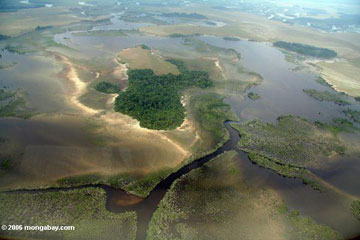Congo rainforest was dry savanna 25,000 years ago
Congo rainforest was dry savanna 25,000 years ago
mongabay.com
March 25, 2007
Scientists from the Netherlands Organization for Scientific Research and University of Bremen in Germany have created the first detailed temperature record for tropical central Africa over the past 25,000 years. Their results confirm the thought that the Congo basin has been considerably drier than it is today.
Developing a new method to reconstruct the history of land temperatures based on the molecular fossils of soil bacteria, the researchers show that tropical Africa was about 4 degree C cooler — or around 21 degree Celsius average temperature — during the past ice ages, whereas the adjacent Atlantic Ocean was only 2.5 degrees cooler. The conditions help explain the changing vegetative communities in the region over the past 25,000 years.
“This large temperature difference between land and ocean surface resulted in drier conditions compared to the current situation, which favours the growth of a lush rainforest,” explained a statement from the Netherlands Organization for Scientific Research. “These findings provide further insight in natural variations in climate and the possible consequences of a warming earth on precipitation in central Africa.”
Many researchers believe that much of the Congo Basin was covered with savanna rather than tropical rainforest during past ice ages due to drier, cooler conditions. This theory has been used to explain biodiversity patterns across the region.
 Forest, swamp, and savanna in Gabon. Photo by Rhett A. Butler |
The new paper, published in the March 23 issue of the journal Science, explains why difference in land and sea temperature would affect temperature and precipitation in the Congo basin.
“By comparing this temperature difference with existing records of continental rainfall variability, lead author Johan Weijers and his colleagues concluded that the land-sea temperature difference has by far the largest influence on continental rainfall,” stated a release from the Netherlands Organization for Scientific Research. “This can be explained by the strong relationship of air pressure to temperature.”
“When the temperature of the sea surface is higher than that of the continent, stronger offshore winds reduce the flow of moist sea air onto the African continent. This occurred during the last ice age and, as a consequence, the land climate in tropical Africa was drier than it is in today’s world, where it favours the growth of a lush rainforest. These results provide further insight into the natural variation of climate and the possible consequences of a warming earth on precipitation in central Africa.”







